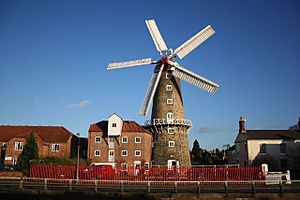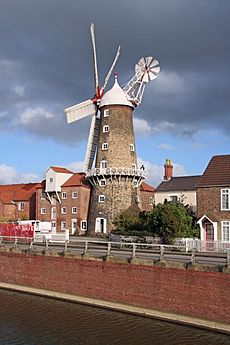Maud Foster Windmill facts for kids
Quick facts for kids Maud Foster Windmill |
|
|---|---|

Maud Foster Mill, January 2008
|
|
| Origin | |
| Mill location | Boston, Lincolnshire |
| Coordinates | 52°59′01″N 0°01′04″W / 52.9835°N 0.0178°W |
| Operator(s) | James Waterfield |
| Year built | 1819 |
| Information | |
| Purpose | Corn mill |
| Type | Tower mill |
| Storeys | Seven storey |
| No. of sails | Five |
| Type of sails | Patent sails |
| Windshaft | Cast iron |
| Winding | Fantail |
| Fantail blades | Eight blades |
| No. of pairs of millstones | Three pairs |
The Maud Foster Windmill is a very tall windmill located in Boston, Lincolnshire, England. It stands next to the Maud Foster Drain, which is where it gets its name. This windmill is one of the biggest working windmills in England. It is about 80 feet (24 meters) tall, reaching up to the top of its cap.
This amazing tower mill and its nearby granary are special. They are listed as a Grade I building, meaning they are very important historically. The mill was built in 1819 for two brothers, Isaac and Thomas Reckitt. It was carefully repaired and brought back to life in 1988.
History of the Maud Foster Windmill
The Maud Foster Windmill was built in 1819. It was made for Thomas and Isaac Reckitt by skilled builders called millwrights from Hull. These millwrights were named Norman and Smithson. The mill was placed on Willoughby Road, right by the Maud Foster Drain.
Grain for the mill used to arrive by barges traveling along the drain. Records show that building the mill cost £1826, 10 shillings, and 6 pence. The Reckitt brothers were millers, meaning they ground grain. They also bought and sold corn and ran a bakery.
However, after a few years of bad harvests, they sold the mill in 1833. Isaac Reckitt later moved away and started a famous company called Reckitt & Sons.
The Ostler family bought the mill in 1914. They ran the business, known as Ostler's Mill, until 1948. After that, the mill closed down and started to fall apart. In 1953, Isaac Reckitt's great-grandson, Basil, helped save it. He arranged for money from family charities to fix the mill. In the same year, the mill was recognized as a building of great historical importance.
In 1987, James Waterfield and his family bought the mill. They worked hard to restore it in 1988. Now, it is fully working again and is the most productive windmill in England. Visitors can explore all seven floors of the mill. They can watch how grain is ground into flour. From the balcony, they can enjoy great views of the town. The mill also has a shop that sells flour and porridge.
Structure of the Maud Foster Windmill
The mill tower has seven levels and is built from a type of brick called gault brick. Each level has windows that slide open, with curved tops. The very top of the mill has a special curved cap. This cap is made of white painted wood and canvas. It holds the mill's five sails and a fantail. A fantail is a small windmill at the back that helps turn the main cap into the wind.
On the third floor, there is a wooden balcony that sticks out. It is supported by strong wooden brackets. To get into the mill, you walk up three stone steps to a pair of wooden doors.
Next to the mill is a three-story building called the granary. It is made of red brick and has a sloped roof covered with curved tiles. The granary has four sections. One section has large wooden doors for bringing in goods. The other three sections have windows similar to those on the mill tower. Above the main doors, there is a small, gabled roof structure called a lucam. This lucam is also made of wood and helps with lifting things into the granary.
Equipment Inside the Mill
The Maud Foster Windmill still has its original floor beams and machinery from 1819. This equipment was made by the millwrights Norman and Smithson. The mill has three sets of grinding stones, and they are all in working order.
Most windmills have four sails, but this mill has five special "patent sails." These sails have shutters that can be opened or closed to control the wind. An interesting part of this mill is its weather beam, which is a main support beam. It is made of cast iron, likely replacing an older wooden one. The brake wheel, which helps stop the mill, is made of wood with an iron ring. The wallower, another important gear, is made of iron. It uses friction to power the sack hoist, which lifts sacks of grain. The dust floor, where dust from milling collects, is quite large and has windows for light.
On the fourth floor, you can see three pairs of grinding stones. Two are grey stones, and one is a French stone. All the parts needed for grinding, like vats and spouts, are still there. The great spur wheel, a large gear, is made of iron. The main upright shaft is also iron. The smaller gears, called stone nuts, have wooden teeth. The spout floor gives access to the reefing stage, where workers can adjust the sails. This floor also has a clever device called a governor. It controls all three pairs of grinding stones. The bridge trees, which support the grinding stones, are made of iron and have a unique Y-shape.



